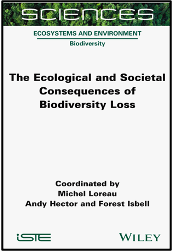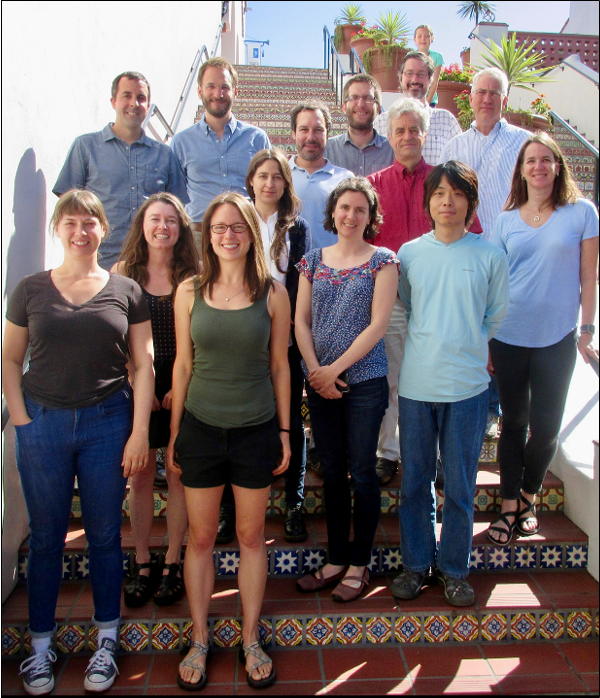A full list of publications is available from Google Scholar, Web of Science, and ORCiD.
Book

Loreau, M., A. Hector, and F. Isbell. Editors. 2022. The Ecological and Societal Consequences of Biodiversity Loss. 2022. Wiley-ISTE. London and Hoboken.
Available for free (with institutional subscription) here.
Selected publications
- Isbell, F., Patricia Balvanera, Akira S Mori, Jin-Sheng He, James M. Bullock, Ganga Ram Regmi, Eric W. Seabloom, Simon Ferrier, Osvaldo E. Sala, Nathaly R. Guerrero-Ramírez, Julia Tavella, Daniel J. Larkin, Bernhard Schmid, Charlotte L. Outhwaite, Pairot Pramual, Elizabeth T. Borer, Michel Loreau, Taiwo Crossby Omotoriogun, David O. Obura, Maggie Anderson, Cristina Portales-Reyes, Kevin Kirkman, Pablo M Vergara, Adam Thomas Clark, Kimberly J Komatsu, Owen L. Petchey, Sarah R. Weiskopf, Laura J. Williams, Scott L. Collins, Nico Eisenhauer, Christopher H Trisos, Delphine Renard, Alexandra J. Wright, Poonam Tripathi, Jane Cowles, Jarrett E.K. Byrnes, Peter B Reich, Andy Purvis, Zati Sharip, Mary I. O'Connor, Clare E. Kazanski, Nick M. Haddad, Eulogio H. Soto, Laura E. Dee, Sandra Díaz, Chad R. Zirbel, Meghan L. Avolio, Shaopeng Wang, Zhiyuan Ma, Jingjing Liang, Hanan C. Farah, Justin Andrew Johnson, Brian W. Miller, Yann Hautier, Melinda D. Smith, Johannes M H Knops, Bonnie J.E. Myers, Zuzana V. Harmáčková, Jorge Cortés, Michael B. J. Harfoot, Andrew Gonzalez, Tim Newbold, Jacqueline Oehri, Marina Mazón, Cynnamon Dobbs, and Meredith S. Palmer. 2023. Expert perspectives on global biodiversity loss and its drivers and impacts on people. Frontiers in Ecology and the Environment 21:94-103. https://doi.org/10.1002/fee.2536 See related video here.
- Mori et al. 2021. Biodiversity-productivity relationships are key to nature-based climate solutions. Nature Climate Change 11:543-550.
- Díaz et al. 2020. Ambitious goals and holistic actions for biodiversity. Science 370:411-413.
- Jochum et al. 2020. The results of biodiversity-ecosystem functioning experiments are realistic. Nature Ecology and Evolution 4:1485-1494.
- Isbell et al. 2019. Deficits of biodiversity and productivity linger a century after agricultural abandonment. Nature Ecology and Evolution 3:1533-1538.
- Komatsu et al. 2019. Global change effects on plant communities are magnified by time and the number of global change factors imposed. PNAS 116:17867-17873.
- Wang et al. 2019. Diversifying livestock promotes multidiversity and multifunctionality in managed grasslands. PNAS 116:6187-6192.
- Isbell et al. 2018. Quantifying effects of biodiversity on ecosystem functioning across times and places. Ecology Letters 21:763-778.
- Hautier et al. 2018. Local loss and spatial homogenization of plant diversity reduce ecosystem multifunctionality. Nature Ecology & Evolution 2:50-56.
- Craven et al. 2018. Multiple facets of biodiversity drive the diversity-stability relationship. Nature Ecology & Evolution 2:1579-1587.
- Binder et al. 2018. Grassland biodiversity can pay. PNAS 115:3876-3881.
- Isbell et al. 2017. Linking the influence and dependence of people on biodiversity across scales. Nature 546:65-72.
- Isbell et al. 2017. Benefits of increasing plant diversity in sustainable agroecosystems. Journal of Ecology 105:871-879.
- Guerrero-Ramírez et al. 2017. Diversity-dependent temporal divergence of ecosystem functioning in experimental ecosystems. Nature Ecology & Evolution 1:1639-1642.
- Isbell et al. 2015. Biodiversity increases the resistance of ecosystem productivity to climate extremes. Nature 526:574-577.
- Isbell et al. 2015. The biodiversity-dependent ecosystem service debt. Ecology Letters 18:119-134.
- Isbell 2015. Agroecosystem diversification. Nature Plants 1:15041.
- Lefcheck et al. 2015. Biodiversity enhances ecosystem multifunctionality across trophic levels and habitats. Nature Communications 6:6936.
- Hautier et al. 2015. Anthropogenic environmental changes affect ecosystem stability via biodiversity. Science 348:336-340.
- Tilman and Isbell 2015. Biodiversity: Recovery as nitrogen declines. Nature 528:336-337.
- Isbell et al. 2013. Nutrient enrichment, biodiversity loss, and consequent declines in ecosystem productivity. PNAS 110:11911-11916.
- Isbell et al. 2013. Low biodiversity state persists two decades after cessation of nutrient enrichment. Ecology Letters 16:454-460.
- Reich et al. 2012. Impacts of biodiversity loss escalate through time as redundancy fades. Science 336:589-592.
- Tilman et al. 2012. Biodiversity impacts ecosystem productivity as much as resources, disturbance, or herbivory. PNAS 109:10394-10397.
- Isbell et al. 2011. High plant diversity is needed to maintain ecosystem services. Nature 477:199-202.
- Isbell and Wilsey. 2011. Increasing native, but not exotic, biodiversity increases aboveground productivity in ungrazed and intensely grazed grasslands Oecologia 165: 771-781.
- Isbell et al. 2009. Biodiversity, productivity and the temporal stability of productivity: patterns and processes. Ecology Letters 12:443-451.
Science-Policy Reports and Expert Information Documents
Expert input to the United Nations Convention on Biodiversity Post-2020 Global Biodiversity Framework
- Leadley et al. 2022. Expert input to the post-2020 global biodiversity framework: transformative actions on all drivers of biodiversity loss are urgently required to achieve the global goals by 2050. Subsidiary Body on Scientific, Technical and Technological Advice, Convention on Biological Diversity, CBD/SBSTTA/24/inf/31.
- Díaz et al. 2020. Synthesizing the scientific evidence to inform the development of the post-2020 Global Framework on Biodiversity. Earth Commission Meeting Report to the Convention on Biological Diversity. Subsidiary Body on Scientific, Technical and Technological Advice, Convention on Biological Diversity, CBD/SBSTTA/24/inf/9
Intergovernmental Science-Policy Platform for Biodiversity and Ecosystem Services (IPBES)
- Barger et al. 2018. Direct and indirect drivers of land degradation and restoration. Chapter 3 in the IPBES assessment report on land degradation and restoration. Eds. L. Montanarella, R. Scholes, and A. Brainich. IPBES Secretariat, Bonn, Germany, pages 198-314.
- Cavender-Bares et al. 2018. Status and trends of biodiversity and ecosystem functions underpinning nature’s benefit to people. Chapter 3 in the IPBES regional assessment report on biodiversity and ecosystem services for the Americas. Eds. J. Rice, C. S. Seixas, M. E. Zaccagnini, M. Bedoya-Gaitán, and N. Valderrama. IPBES Secretariat, Bonn, Germany, pages 207-362.
- Bustamente et al. 2018. Direct and indirect drivers of change in biodiversity and nature’s contributions to people. Chapter 4 in the IPBES regional assessment report on biodiversity and ecosystem services for the Americas. Eds. J. Rice, C. S. Seixas, M. E. Zaccagnini, M. Bedoya-Gaitán, and N. Valderrama. IPBES Secretariat, Bonn, Germany, pages 363-537.
Synthesis science
Our research is highly collaborative. Many of our publications are products from international synthesis working groups and workshops, including:
- Ecosystem transitions, PIs: Cristy Portales-Reyes and Anny Chung, supported by NSF LTER at NCEAS, 2021-present
- Biodiversity and ecosystem services, PIs: Sarah Weiskopf and Isabel Rosa, supported by NSF at SESYNC, 2019-present
- Scaling-up BEF, PIs: Forest Isbell, Jane Cowles, and Laura Dee, supported by NSF LTER at NCEAS, 2017-2020 (see picture)
- Communities to ecosystems, PIs: Kim Komatsu, Meghan Avolio, and Kevin Wilcox, supported by NSF LTER at NCEAS, 2016-2019
- Biodiversity Change, PIs: Andy Gonzalez and Mary O'Connor, supported by Canadian Institute of Ecology and Evolution, 2015
- Biodiversity Change, PIs: Forest Isbell and Nico Eisenhauer, supported by DFG at sDiv, 2014
- sTability, PIs: Nico Eisenhauer and Forest Isbell, supported by DFG at sDiv, 2013-2015
- Convergence and divergence, PIs: Meghan Avolio and Kim Komatsu, supported by NSF LTER, 2012-2013
- Diversity-Function, PIs: Dave Hooper, Emmett Duffy, Brad Cardinale, supported by NSF NCEAS, 2011
- Modeling BEF Relationships, PI: John Connolly, supported by Science Foundation Ireland, 2011
- Plant Interaction Networks, PI: Bernhard Schmid, supported by Swiss Systems X, 2009
